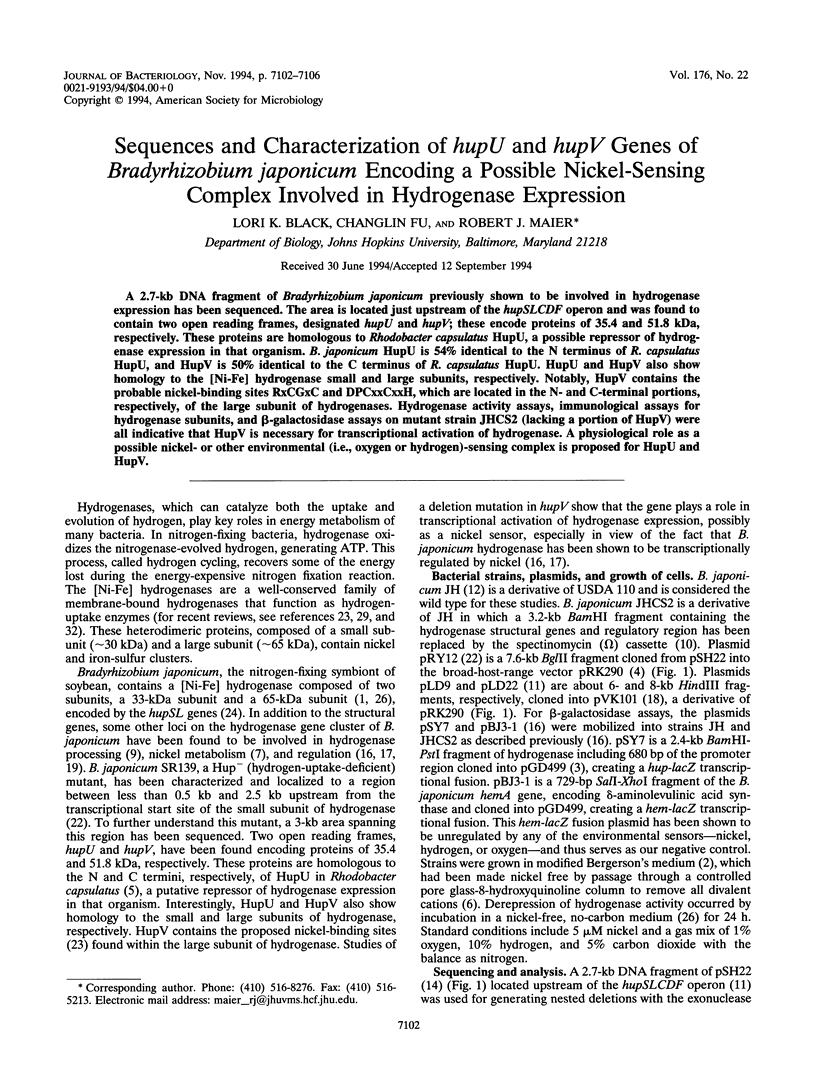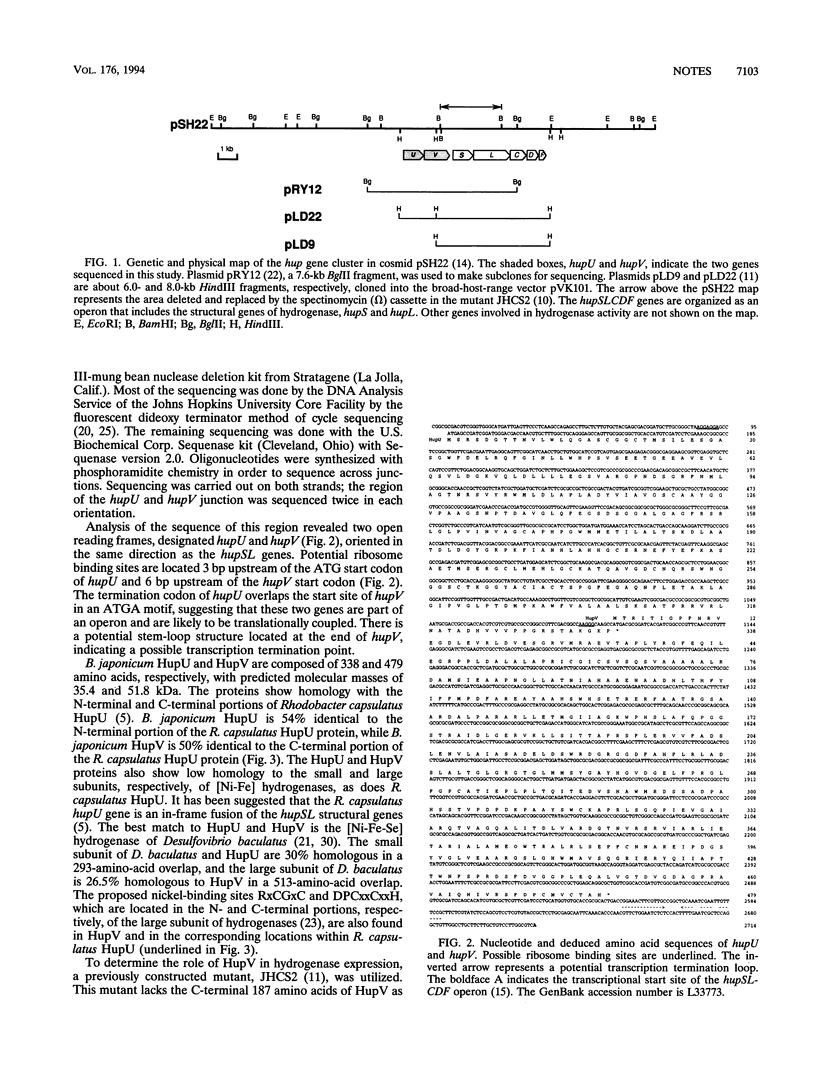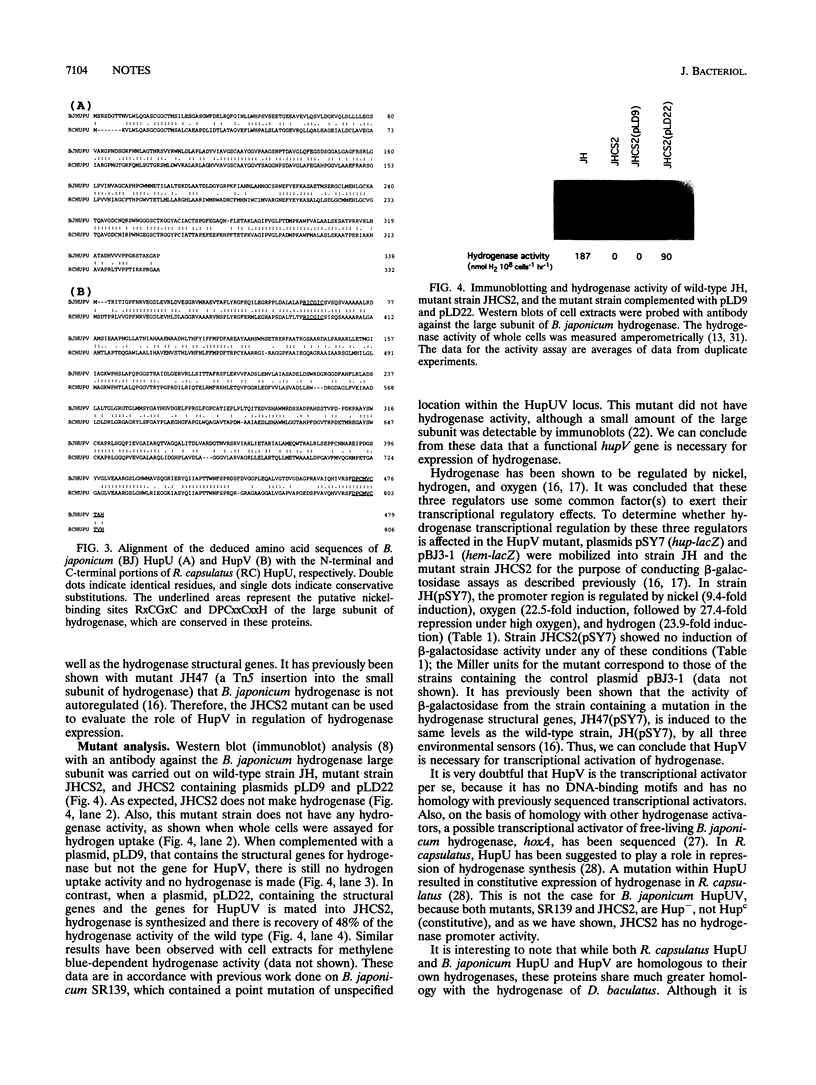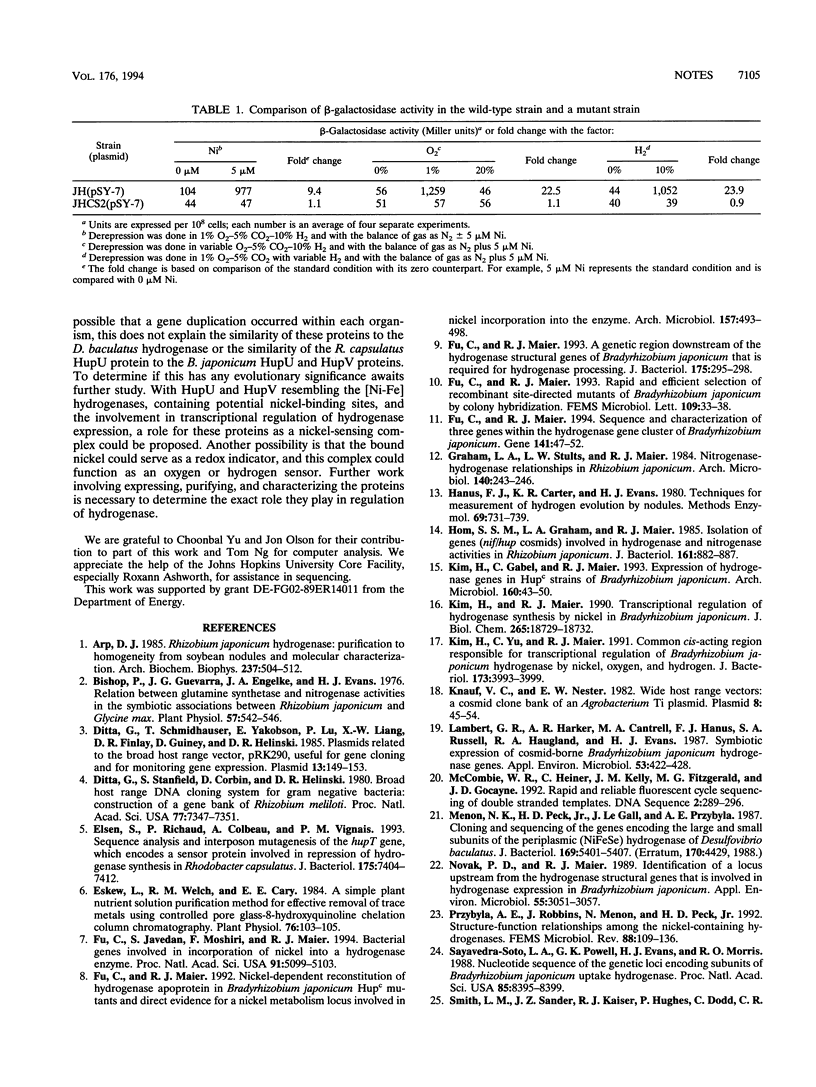Abstract
A 2.7-kb DNA fragment of Bradyrhizobium japonicum previously shown to be involved in hydrogenase expression has been sequenced. The area is located just upstream of the hupSLCDF operon and was found to contain two open reading frames, designated hupU and hupV; these encode proteins of 35.4 and 51.8 kDa, respectively. These proteins are homologous to Rhodobacter capsulatus HupU, a possible repressor of hydrogenase expression in that organism. B. japonicum HupU is 54% identical to the N terminus of R. capsulatus HupU, and HupV is 50% identical to the C terminus of R. capsulatus HupU. HupU and HupV also show homology to the [Ni-Fe] hydrogenase small and large subunits, respectively. Notably, HupV contains the probable nickel-binding sites RxCGxC and DPCxxCxxH, which are located in the N- and C-terminal portions, respectively, of the large subunit of hydrogenases. Hydrogenase activity assays, immunological assays for hydrogenase subunits, and beta-galactosidase assays on mutant strain JHCS2 (lacking a portion of HupV) were all indicative that HupV is necessary for transcriptional activation of hydrogenase. A physiological role as a possible nickel- or other environmental (i.e., oxygen or hydrogen)-sensing complex is proposed for HupU and HupV.
Full text
PDF




Images in this article
Selected References
These references are in PubMed. This may not be the complete list of references from this article.
- Arp D. J. Rhizobium japonicum hydrogenase: purification to homogeneity from soybean nodules, and molecular characterization. Arch Biochem Biophys. 1985 Mar;237(2):504–512. doi: 10.1016/0003-9861(85)90303-0. [DOI] [PubMed] [Google Scholar]
- Bishop P. E., Guevara J. G., Engelke J. A., Evans H. J. Relation between Glutamine Synthetase and Nitrogenase Activities in the Symbiotic Association between Rhizobium japonicum and Glycine max. Plant Physiol. 1976 Apr;57(4):542–546. doi: 10.1104/pp.57.4.542. [DOI] [PMC free article] [PubMed] [Google Scholar]
- Ditta G., Schmidhauser T., Yakobson E., Lu P., Liang X. W., Finlay D. R., Guiney D., Helinski D. R. Plasmids related to the broad host range vector, pRK290, useful for gene cloning and for monitoring gene expression. Plasmid. 1985 Mar;13(2):149–153. doi: 10.1016/0147-619x(85)90068-x. [DOI] [PubMed] [Google Scholar]
- Ditta G., Stanfield S., Corbin D., Helinski D. R. Broad host range DNA cloning system for gram-negative bacteria: construction of a gene bank of Rhizobium meliloti. Proc Natl Acad Sci U S A. 1980 Dec;77(12):7347–7351. doi: 10.1073/pnas.77.12.7347. [DOI] [PMC free article] [PubMed] [Google Scholar]
- Elsen S., Richaud P., Colbeau A., Vignais P. M. Sequence analysis and interposon mutagenesis of the hupT gene, which encodes a sensor protein involved in repression of hydrogenase synthesis in Rhodobacter capsulatus. J Bacteriol. 1993 Nov;175(22):7404–7412. doi: 10.1128/jb.175.22.7404-7412.1993. [DOI] [PMC free article] [PubMed] [Google Scholar]
- Eskew D. L., Welch R. M., Cary E. E. A simple plant nutrient solution purification method for effective removal of trace metals using controlled pore glass-8-hydroxyquinoline chelation column chromatography. Plant Physiol. 1984 Sep;76(1):103–105. doi: 10.1104/pp.76.1.103. [DOI] [PMC free article] [PubMed] [Google Scholar]
- Fu C., Javedan S., Moshiri F., Maier R. J. Bacterial genes involved in incorporation of nickel into a hydrogenase enzyme. Proc Natl Acad Sci U S A. 1994 May 24;91(11):5099–5103. doi: 10.1073/pnas.91.11.5099. [DOI] [PMC free article] [PubMed] [Google Scholar]
- Fu C., Maier R. J. A genetic region downstream of the hydrogenase structural genes of Bradyrhizobium japonicum that is required for hydrogenase processing. J Bacteriol. 1993 Jan;175(1):295–298. doi: 10.1128/jb.175.1.295-298.1993. [DOI] [PMC free article] [PubMed] [Google Scholar]
- Fu C., Maier R. J. Nickel-dependent reconstitution of hydrogenase apoprotein in Bradyrhizobium japonicum Hupc mutants and direct evidence for a nickel metabolism locus involved in nickel incorporation into the enzyme. Arch Microbiol. 1992;157(6):493–498. doi: 10.1007/BF00276768. [DOI] [PubMed] [Google Scholar]
- Fu C., Maier R. J. Rapid and efficient selection of recombinant site-directed mutants of Bradyrhizobium japonicum by colony hybridization. FEMS Microbiol Lett. 1993 May 1;109(1):33–38. doi: 10.1111/j.1574-6968.1993.tb06139.x. [DOI] [PubMed] [Google Scholar]
- Fu C., Maier R. J. Sequence and characterization of three genes within the hydrogenase gene cluster of Bradyrhizobium japonicum. Gene. 1994 Apr 8;141(1):47–52. doi: 10.1016/0378-1119(94)90126-0. [DOI] [PubMed] [Google Scholar]
- Hom S. S., Graham L. A., Maier R. J. Isolation of genes (nif/hup cosmids) involved in hydrogenase and nitrogenase activities in Rhizobium japonicum. J Bacteriol. 1985 Mar;161(3):882–887. doi: 10.1128/jb.161.3.882-887.1985. [DOI] [PMC free article] [PubMed] [Google Scholar]
- Kim H., Gabel C., Maier R. J. Expression of hydrogenase in Hupc strains of Bradyrhizobium japonicum. Arch Microbiol. 1993;160(1):43–50. doi: 10.1007/BF00258144. [DOI] [PubMed] [Google Scholar]
- Kim H., Maier R. J. Transcriptional regulation of hydrogenase synthesis by nickel in Bradyrhizobium japonicum. J Biol Chem. 1990 Nov 5;265(31):18729–18732. [PubMed] [Google Scholar]
- Kim H., Yu C., Maier R. J. Common cis-acting region responsible for transcriptional regulation of Bradyrhizobium japonicum hydrogenase by nickel, oxygen, and hydrogen. J Bacteriol. 1991 Jul;173(13):3993–3999. doi: 10.1128/jb.173.13.3993-3999.1991. [DOI] [PMC free article] [PubMed] [Google Scholar]
- Knauf V. C., Nester E. W. Wide host range cloning vectors: a cosmid clone bank of an Agrobacterium Ti plasmid. Plasmid. 1982 Jul;8(1):45–54. doi: 10.1016/0147-619x(82)90040-3. [DOI] [PubMed] [Google Scholar]
- Lambert G. R., Harker A. R., Cantrell M. A., Hanus F. J., Russell S. A., Haugland R. A., Evans H. J. Symbiotic Expression of Cosmid-Borne Bradyrhizobium japonicum Hydrogenase Genes. Appl Environ Microbiol. 1987 Feb;53(2):422–428. doi: 10.1128/aem.53.2.422-428.1987. [DOI] [PMC free article] [PubMed] [Google Scholar]
- McCombie W. R., Heiner C., Kelley J. M., Fitzgerald M. G., Gocayne J. D. Rapid and reliable fluorescent cycle sequencing of double-stranded templates. DNA Seq. 1992;2(5):289–296. doi: 10.3109/10425179209030961. [DOI] [PubMed] [Google Scholar]
- Menon N. K., Peck H. D., Jr, Gall J. L., Przybyla A. E. Cloning and sequencing of the genes encoding the large and small subunits of the periplasmic (NiFeSe) hydrogenase of Desulfovibrio baculatus. J Bacteriol. 1987 Dec;169(12):5401–5407. doi: 10.1128/jb.169.12.5401-5407.1987. [DOI] [PMC free article] [PubMed] [Google Scholar]
- Novak P. D., Maier R. J. Identification of a Locus Upstream from the Hydrogenase Structural Genes That Is Involved in Hydrogenase Expression in Bradyrhizobium japonicum. Appl Environ Microbiol. 1989 Dec;55(12):3051–3057. doi: 10.1128/aem.55.12.3051-3057.1989. [DOI] [PMC free article] [PubMed] [Google Scholar]
- Przybyla A. E., Robbins J., Menon N., Peck H. D., Jr Structure-function relationships among the nickel-containing hydrogenases. FEMS Microbiol Rev. 1992 Feb;8(2):109–135. doi: 10.1111/j.1574-6968.1992.tb04960.x. [DOI] [PubMed] [Google Scholar]
- Sayavedra-Soto L. A., Powell G. K., Evans H. J., Morris R. O. Nucleotide sequence of the genetic loci encoding subunits of Bradyrhizobium japonicum uptake hydrogenase. Proc Natl Acad Sci U S A. 1988 Nov;85(22):8395–8399. doi: 10.1073/pnas.85.22.8395. [DOI] [PMC free article] [PubMed] [Google Scholar]
- Smith L. M., Sanders J. Z., Kaiser R. J., Hughes P., Dodd C., Connell C. R., Heiner C., Kent S. B., Hood L. E. Fluorescence detection in automated DNA sequence analysis. Nature. 1986 Jun 12;321(6071):674–679. doi: 10.1038/321674a0. [DOI] [PubMed] [Google Scholar]
- Stults L. W., Moshiri F., Maier R. J. Aerobic purification of hydrogenase from Rhizobium japonicum by affinity chromatography. J Bacteriol. 1986 Jun;166(3):795–800. doi: 10.1128/jb.166.3.795-800.1986. [DOI] [PMC free article] [PubMed] [Google Scholar]
- Van Soom C., Verreth C., Sampaio M. J., Vanderleyden J. Identification of a potential transcriptional regulator of hydrogenase activity in free-living Bradyrhizobium japonicum strains. Mol Gen Genet. 1993 May;239(1-2):235–240. doi: 10.1007/BF00281623. [DOI] [PubMed] [Google Scholar]
- Vignais P. M., Toussaint B. Molecular biology of membrane-bound H2 uptake hydrogenases. Arch Microbiol. 1994;161(1):1–10. doi: 10.1007/BF00248887. [DOI] [PubMed] [Google Scholar]
- Voordouw G., Menon N. K., LeGall J., Choi E. S., Peck H. D., Jr, Przybyla A. E. Analysis and comparison of nucleotide sequences encoding the genes for [NiFe] and [NiFeSe] hydrogenases from Desulfovibrio gigas and Desulfovibrio baculatus. J Bacteriol. 1989 May;171(5):2894–2899. doi: 10.1128/jb.171.5.2894-2899.1989. [DOI] [PMC free article] [PubMed] [Google Scholar]
- Wu L. F., Mandrand M. A. Microbial hydrogenases: primary structure, classification, signatures and phylogeny. FEMS Microbiol Rev. 1993 Apr;10(3-4):243–269. doi: 10.1111/j.1574-6968.1993.tb05870.x. [DOI] [PubMed] [Google Scholar]



